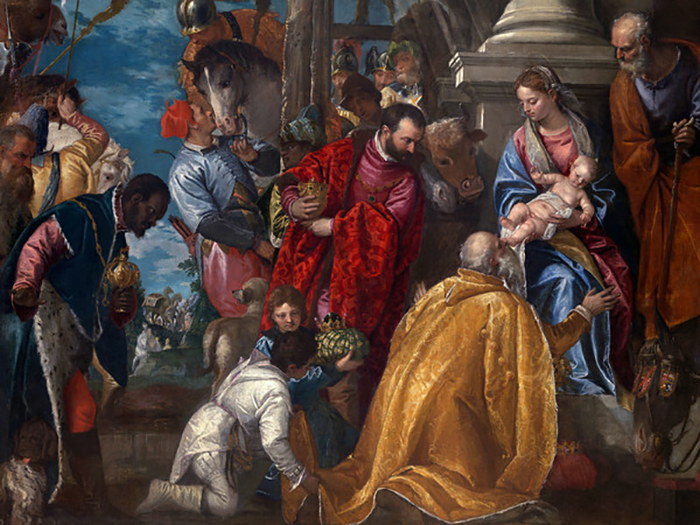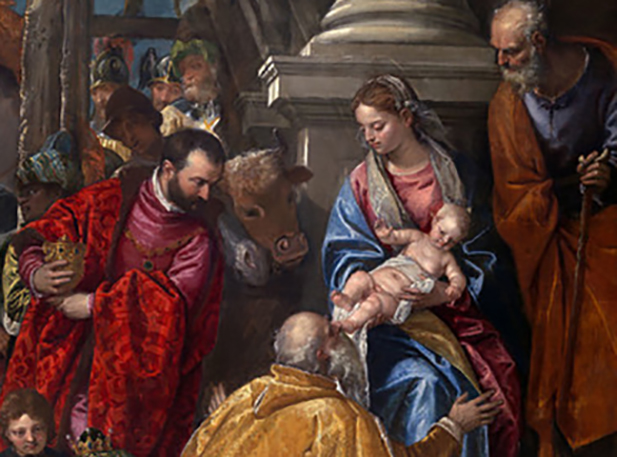January 6: Worshipping Gift Givers
♫ Music:
Monday, January 6
EPIPHANY
Title: WORSHIPPING GIFT GIVERS
Scripture: Matthew 2:11-12
After coming into the house [the magi] saw the Child with Mary His mother; and they fell to the ground and worshiped Him. Then, opening their treasures, they presented to Him gifts of gold, frankincense, and myrrh. And having been warned by God in a dream not to return to Herod, the magi left for their own country by another way.
Poetry:
Salus Mundi
By Mary Coleridge
I saw a stable, low and very bare,
A little child in a manger.
The oxen knew him, had Him in their care,
To men He was a stranger.
The safety of the world was lying there,
And the world’s danger.
WORSHIPPING GIFT GIVERS
Today’s artwork, the lower section of a massive canvas by Paolo Veronese, depicts the culmination of the Magi’s journey from the East. The Venetian painter gives us a lavish visual scene full of luxurious surfaces. Fabric of various sheens, skin tones from rosy to umber, the soft fur of dogs and human hair, ornate metallic objects, all demonstrate the wealth of the exotic visitors and the virtuosity of the painter
Veronese made several paintings on the theme of the Magi, the visual lushness it offered was a perfect match to the Venetian’s gifts for describing color and play of light, and his penchant for graceful gestures. In its celebration of surface, this painting appeals to our sense of touch as well as to our sense of sight, and Veronese reinforces this by depicting several of his characters in the act of lightly touching or holding elements. You might take a moment or two to look at all of the hands in this painting.
Hands and their actions have always been central to worship activities, but the climactic moment of this painting of lips to a foot, bringing the unexpected sensation of the contact of rough beard and soft skin.The painting’s emphasis reminds us that these wealthy and powerful men came a great distance, at great cost, not only to “pay tribute,” but also simply to see and to touch Jesus. Gifts could have been sent through envoys, proxies are always available to the rich and powerful, but these sage men understood that the only proper way to worship, and the only proper way to give and receive blessing, was to present themselves entirely to this infant
Matthew’s Gospel records both the visit of the Magi and the anointing of Jesus at Bethany. These two extravagant moments of beauty, cost, and sacrificial worship are each followed in turn by hideous moments of brutal expedience and de-humanizing violence. All the Infants in the area are murdered by Herod as a matter of convenience; Judas sells his friend and mentor for a meager sum. True worship exposes our hearts, and the hearts of those around us, whatever their condition.
The moment of beauty, grace, and true worship depicted in the Veronese, incarnated in the real Magi and the woman at Bethany, is unusual in the present age. Even in Matthew’s Gospel these events are like two lucid commas in the life of Jesus, pauses where others actually understood who was with them, and how to respond. I long for such beautiful lucidity in my own life.
But here we must remember that the arrival of these earthly kings to worship Jesus was merely a prophetic foreshadowing. The Kingdom of God, which came into the world through the infant they worshipped, is still at hand. It bears only true worship, will subdue all violence, and we affirm today, on Epiphany, that the act of the Magi will have its fulfillment, as it is written:
And the City has no need of sun or moon to shine on it, because the glory of God illuminates the city, and the Lamb its lamp. By its light the nations will walk, and into it the kings of the earth will bring their glory. (Rev 21:23-24)
Prayer:
Jesus, I long to worship you in Spirit and in Truth
And to bring all that I have done, all that I possess,
All that I will be, to you.
Reveal to me the subtle and overt violence
That I have used in worship of myself.
Like the Magi, who searched the scrolls and the heavens
I long for your coming.
Make me ready for your return.
Amen
Jonathan Puls
Associate Dean, School of Fine Arts and Communication
Associate Professor of Art History and Painting
Biola University
For more information about the artwork, music, and poetry selected for this day, we have provided resources under the “About” tab located next to the “Devotional” tab.
About the Artwork:
The Adoration of the Magi (detail)
Paolo Veronese
1573-1575
320 x 234 cm
Oil on canvas
Sacred Spina Chapel of the Church of Santa Corona
Vicenza, Italy
This enormous painting was created by Renaissance artist Veronese for the Sacred Spina Chapel of the Dominican Church of Santa Corona in Vicenza. During the time it took to make this painting, the artist also created numerous large altarpieces characterized by festive colors, striking lighting, and scenic settings. The composition of The Adoration of the Magi is dominated by imposing classical-style temple that alludes to a declining pagan world, and a simple wooden hut that houses the Holy Family. The three Magi, richly dressed in precious fabrics, allude to the work of Veronese’s client, a rich Venetian fabric merchant. Pages and servants, also elegantly dressed, transform the sacred event into a sixteenth-century feast and celebration. After a 2014 restoration of the painting, the richness of the drapery and the exceptional chromatic quality of the painting revealed the genius of Veronese’s style.
About the Artist:
Paolo Veronese (1528–1588) was a Venetian Renaissance painter known for his extremely elaborate, large paintings that depict allegorical, biblical, and historical subjects in splendid color, set in a framework of Renaissance architecture. Included with Titian and Tintoretto, Veronese is one of the "great trio that dominated Venetian painting of the cinquecento" and the Late Renaissance of the 16th century. He is known for "the chromatic brilliance of his palette, the splendor and sensibility of his brushwork, the aristocratic elegance of his figures, and the magnificence of his spectacle,” but his work has been felt "not to permit expression of the profound, the human, or the sublime,” and among the "great trio" he has often been the least appreciated by modern criticism. His large paintings of biblical feasts, painted for the refectories of monasteries in Venice and Verona, are especially famous and largely have remained in situ.
https://www.nationalgallery.org.uk/artists/paolo-veronese
About the Music:
“In the Bleak Midwinter” from the album In the Bleak Midwinter (Single)
Lyrics:
In the bleak midwinter
Frosty wind made moan
Earth stood hard as iron
Water like a stone
Snow had fallen
Snow on snow on snow
In the bleak midwinter
Long, long ago
Angels and archangels
May have traveled there
Cherubim and Seraphim
Thronged the air
But only his Mother
In her maiden bliss
Worshiped the beloved
With a kiss
What can I give him?
Poor as I am
If I were a shepherd
I would give a lamb
If I were a wise man
I would do my part
But what I can I give him
Give him my heart
About the Composer:
Gustav Holst and arranged by Nicholas Yee
Gustav Theodore Holst (1874–1934) was an English composer, arranger, and teacher. Best known for his orchestral suite The Planets, he composed many other works across a range of genres, although none achieved comparable success. His distinctive compositional style was the product of many influences including Richard Wagner and Richard Strauss. The subsequent inspiration of the English folksong revival of the early 20th century, and the example of such rising modern composers as Maurice Ravel, led Holst to develop and refine an individual style. He pursued a career as a composer, studying at the Royal College of Music. Unable to support himself by his compositions, he became a teacher. A reserved man, he did not welcome his fame and preferred to be left to compose and teach. In his later years, his uncompromising, personal style of composition struck many music lovers as too austere and his brief popularity declined. Nevertheless, he was a significant influence on a number of younger English composers.
https://en.wikipedia.org/wiki/Gustav_Holst
About the Lyricist:
Christina Rossetti (1830-1894) was a Victorian poet who is known for her simple, lyrical work. She published poems in the feminist periodicals The English Woman’s Journal and Victoria Magazine and in various other anthologies. Today her poetry is regarded as some of the most beautiful and innovative of the period. Critical interest in Rossetti’s poetry was renewed in the last decades of the twentieth century, a resurgence largely generated by the emergence of feminist criticism. Her work strongly influenced the work of writers such as Ford Madox Ford, Virginia Woolf, Gerard Manley Hopkins, Elizabeth Jennings, and Philip Larkin. Critic Basil de Selincourt stated that she was "all but our greatest woman poet … incomparably our greatest craftswoman … probably in the first twelve of the masters of English verse." Rossetti's Christmas poem "In the Bleak Midwinter" became widely known after her death when set as a Christmas carol first by Gustav Holst and then by Harold Darke. Her poem "Love Came Down at Christmas" has also been widely arranged as a carol.
https://www.poetryfoundation.org/poets/christina-rossetti
About the Performer and Arranger:
Nicholas Yee is a cellist, arranger, and photographer in Edmonton, Alberta, Canada
https://nicholasdyee.com/
About the Poet:
Mary Elizabeth Coleridge (1861–1907) was a British novelist and poet who also wrote essays and reviews. Coleridge grew up in a literary and artistic environment. She was the great-grandniece of Romantic poet Samuel Taylor Coleridge and the daughter of musically talented parents. She lived in a home frequented by distinguished family friends including Alfred Lord Tennyson, Anthony Trollope, John Ruskin, and Robert Browning, among others. Coleridge wrote poetry under the pseudonym “Anodos,” taken from George MacDonald’s central character in the fantasy novel Phantastes. Robert Bridges, Poet, Laureate, described her poems as “wondrously beautiful… but mystical rather and enigmatic.” Coleridge also taught grammar and literature to young women at the Working Women's College as part of her belief that it was her Christian duty to help the poor.
https://www.poetryfoundation.org/poets/mary-elizabeth-coleridge
About the Devotion Writer:
Jonathan Puls
Associate Dean, School of Fine Arts and Communication
Associate Professor of Art History and Painting
Biola University
Jonathan Puls is a painter who serves in faculty and administrative roles at Biola. He has a passion for teaching the integrated history and process of drawing and painting as an extension of his own painting practice. Puls also loves supporting creative work in all the arts at Biola and in the larger community. He, his wife, and his two daughters are constantly engaged in various visual art, music, and theater projects.

